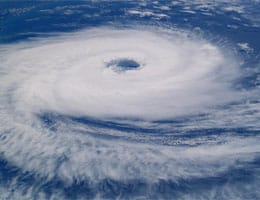 The notion of cyclone comes from the English cyclone , although its most distant etymological origin is found in the Greek language. According to the dictionary of the Royal Spanish Academy ( RAE ), the term can refer to a hurricane .
The notion of cyclone comes from the English cyclone , although its most distant etymological origin is found in the Greek language. According to the dictionary of the Royal Spanish Academy ( RAE ), the term can refer to a hurricane .
A cyclone, therefore, is a wind of great intensity that rotates in circles like a whirlwind . The concept can also be linked to the phenomenon that develops when these winds occur together with storms , generating storms .
Cyclones originate in the area of the atmosphere where the pressure is lower than that of the surroundings. The intensity of the wind can cause all kinds of damage; Torrential rainfall also often causes flooding.
It is common for ideas such as cyclone, hurricane and typhoon to be used as synonyms in everyday language. Meteorologists explain that they are similar phenomena: if the system forms in the western Pacific , it is called a cyclone or typhoon, while if it forms in the northern Atlantic , it is called a hurricane. The last phase of the cyclone is also usually called a hurricane, which completes the process begun with a tropical disturbance , which is followed by a tropical depression and then a tropical storm .
The wind speed in a cyclone is at least 119 kilometers per hour . The eye of the whirlwind has a diameter of around 30 kilometers , although cyclones with a diameter of about 100 kilometers at their center have occurred.
Cyclones are classified into categories 1 to 5 . The most intense are category 5 cyclones, with winds of more than 252 kilometers per hour .
Depending on its type, we can recognize the following types of cyclone:
* tropical : this type of cyclone has been mentioned in the previous paragraphs, as it is also known as a hurricane, typhoon and tropical storm . Its formation usually takes place in hot oceans, where it takes the energy that comes from condensation and evaporation. It is characterized by having an area of strong low pressure on the surface and one of high pressure in the upper levels of the atmosphere. Its power of destruction is really considerable , since it is accompanied by very powerful rains and winds;
 * extratropical : its formation takes place in latitudes beyond 30°. It is made up of a minimum of two air masses, which is why it is associated with an equal number of fronts. Since this type of cyclone makes up a very large family, specialists are trying to find the definition of a subfamily. This is not easy because each one has apparently unique and unrepeatable characteristics , although certain studies have shown results that point to the presence of certain common traits;
* extratropical : its formation takes place in latitudes beyond 30°. It is made up of a minimum of two air masses, which is why it is associated with an equal number of fronts. Since this type of cyclone makes up a very large family, specialists are trying to find the definition of a subfamily. This is not easy because each one has apparently unique and unrepeatable characteristics , although certain studies have shown results that point to the presence of certain common traits;
* subtropical : this is a system that has certain features generally associated with tropical and extratropical cyclones. They generally form in latitudes close to the equator;
* polar : with respect to its size it is comparable to the tropical one, although it usually has a less extensive life. Generally, its diameter reaches hundreds of kilometers and it has strong winds. One of the most obvious differences with the tropical one is that its development is much faster, since its maximum strength is reached in just 24 hours.
As a proper name we find it in several examples, such as Club Atlético Ciclón , a Bolivian soccer team that is also known as Ciclón de la Pampa . More specifically, it belongs to the city of Tarija, the one with the largest population in its department, also called Tarija. It was founded by Mauricio Peñaloza with the help of some friends who wanted to play in the city 's league, in 1951. Their home games are played at the IV Centenario Stadium .
